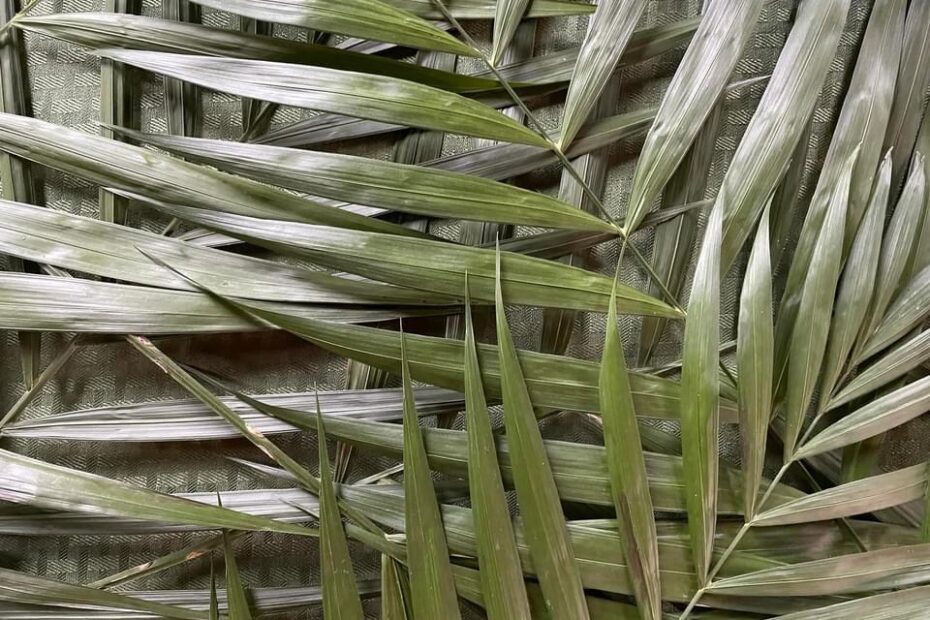If you are looking for fun and creative Easter prayer ideas, setting up some interactive prayer stations to tell the story of Holy Week and Easter is a great option. These fun, interactive prayer stations are a little bit like the Stations of the Cross (but focusing on different moments and more sensory based). This would be a great way to tell the Easter story in any church, or even in the classroom or at home.
This is a great way to pray on Good Friday or Holy Saturday, before the celebration of Christ’s resurrection on Easter Sunday. The last of these prayer stations end with “Jesus is buried” and “Jesus died for our sin”. If you are doing these on Easter Sunday, you would want to add another station for “Jesus is risen”.
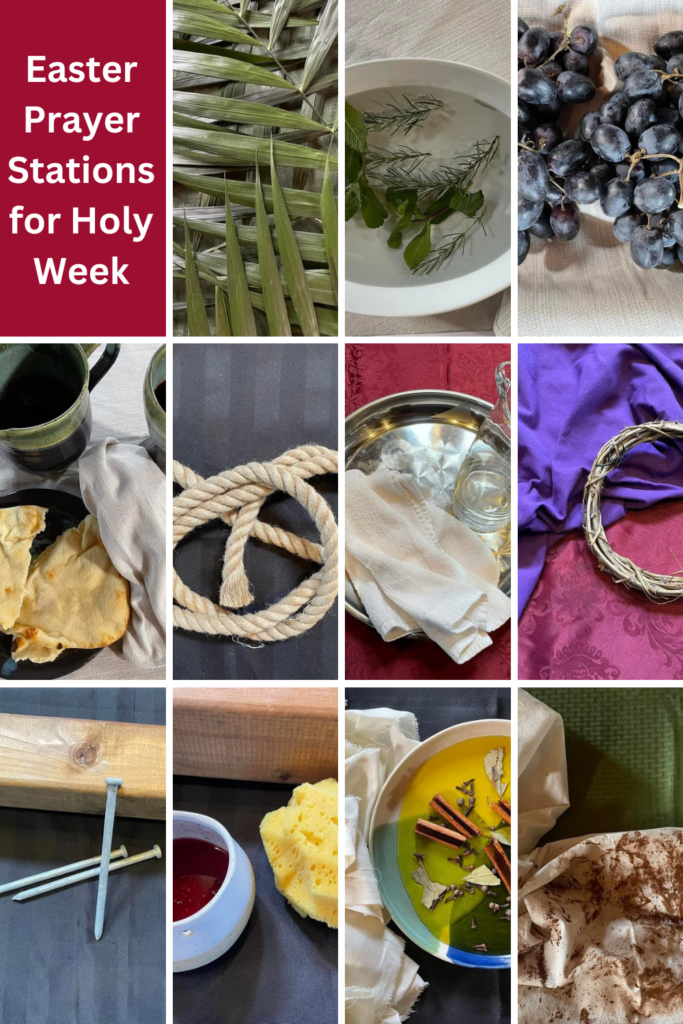
Creative Easter Prayer Stations to Tell the Story of Holy Week
These creative prayer stations tell the story of Holy Week: Jesus’ triumphal entry into Jerusalem, his last supper, his arrest and trial, his death and resurrection. These stations are a great way to create an interactive Good Friday or Holy Week experience for your church, children’s ministry, youth ministry, classroom, or at home.
You can set these prayer stations up in any large space in your church. Gather the materials and lay them out next to the Bible passages and instructions for each station.
Materials Needed
- palm leaves
- bowl
- water
- fresh herbs
- grapes
- bread
- wine or grape juice (don’t use wine unless you’re confident that it’s only adults who will be going through these stations and that wine won’t pose a problem)
- piece of rope
- jug and dish for water
- towel for washing hands
- crown of thorns
- purple fabric
- large piece of wood
- 3 large nails
- vinegar in a dish
- sponge
- strips of linen or other cloth
- cinnamon, cloves, bay leaves and oil
- another dish
- cocoa powder
- small bowl
- large piece of white cloth
Instructions
Set up each station at a table with the tactile pieces of the prayer station, along with the Bible verses and the questions. Have participants start at the palm leaves station, representing Palm Sunday, and progress through the prayer stations all the way to the final station with cocoa powder and a white cloth.
You can play soft music in the background for ambience. And these prayer stations can be used almost anywhere: at church, at home, outdoors…. These prayer stations are a great way to encourage all ages to interact with the story of Holy Week in a tactile way. This also offers participants a chance to pause and reflect on each part of the story.

Palm leaves: Jesus’ triumphal entry into Jeruslem
They brought it to Jesus, threw their cloaks on the colt and put Jesus on it. As he went along, people spread their cloaks on the road.
When he came near the place where the road goes down the Mount of Olives, the whole crowd of disciples began joyfully to praise God in loud voices for all the miracles they had seen:
“Blessed is the king who comes in the name of the Lord!”
“Peace in heaven and glory in the highest!”
Some of the Pharisees in the crowd said to Jesus, “Teacher, rebuke your disciples!”
“I tell you,” he replied, “if they keep quiet, the stones will cry out.”
Luke 19:35-40
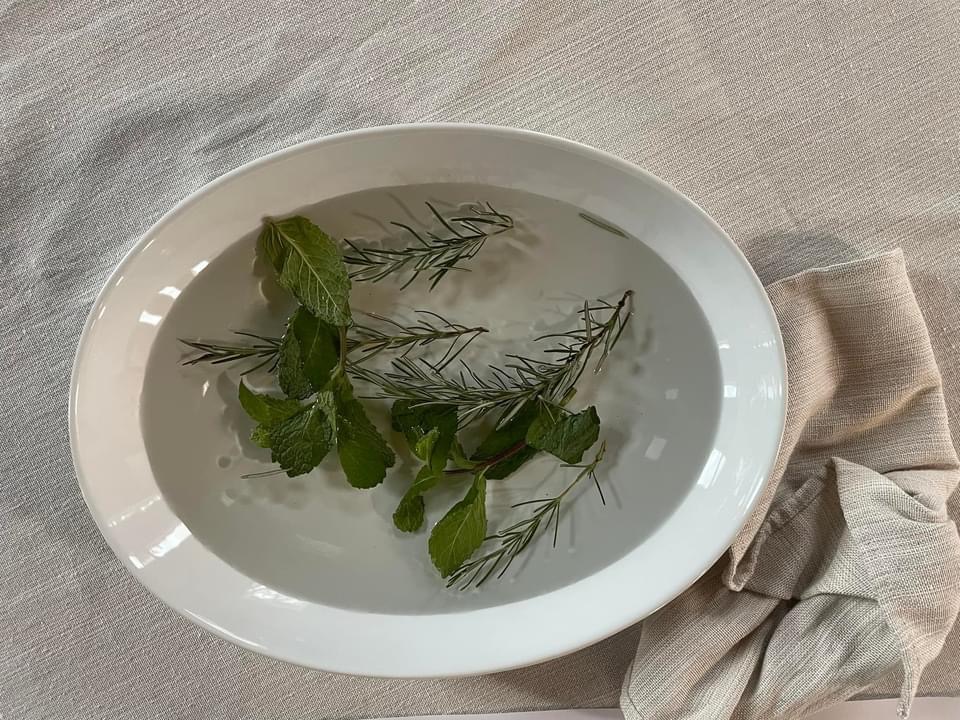
Water and herbs: Jesus washes the disciples feet
It was just before the Passover Festival. Jesus knew that the hour had come for him to leave this world and go to the Father. Having loved his own who were in the world, he loved them to the end.
The evening meal was in progress, and the devil had already prompted Judas, the son of Simon Iscariot, to betray Jesus. Jesus knew that the Father had put all things under his power, and that he had come from God and was returning to God; so he got up from the meal, took off his outer clothing, and wrapped a towel around his waist. After that, he poured water into a basin and began to wash his disciples’ feet, drying them with the towel that was wrapped around him.
He came to Simon Peter, who said to him, “Lord, are you going to wash my feet?”
Jesus replied, “You do not realize now what I am doing, but later you will understand.”
“No,” said Peter, “you shall never wash my feet.”
Jesus answered, “Unless I wash you, you have no part with me.”
“Then, Lord,” Simon Peter replied, “not just my feet but my hands and my head as well!”
Jesus answered, “Those who have had a bath need only to wash their feet; their whole body is clean. And you are clean, though not every one of you.” For he knew who was going to betray him, and that was why he said not every one was clean.
When he had finished washing their feet, he put on his clothes and returned to his place. “Do you understand what I have done for you?” he asked them. “You call me ‘Teacher’ and ‘Lord,’ and rightly so, for that is what I am. Now that I, your Lord and Teacher, have washed your feet, you also should wash one another’s feet. I have set you an example that you should do as I have done for you. Very truly I tell you, no servant is greater than his master, nor is a messenger greater than the one who sent him. Now that you know these things, you will be blessed if you do them.
John 13:1-17
In Jesus’ day, most people walked wherever they needed to go and nobody had very good shoes or good sandals. This meant that everyone’s feet were hard, dirty, and smelly by the end of the day. Cleaning someone’s feet was a job for the lowest servant.
Place your hand in the water and take a deep sniff. Do you think the disciples would have felt relaxed afterward?
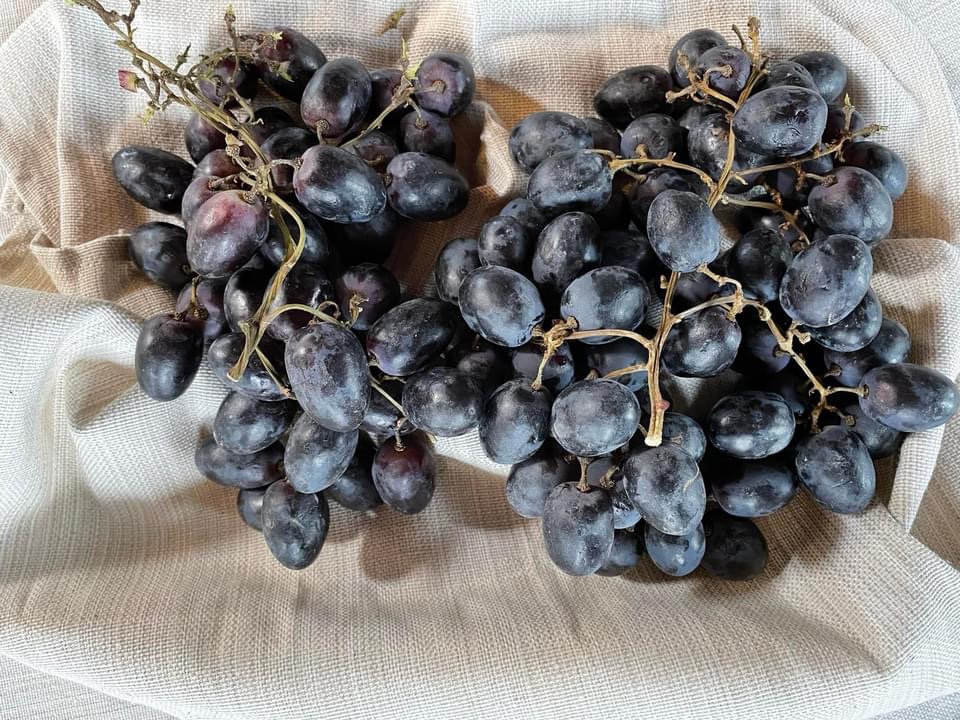
Grapes: The Vine and The Branches
“I am the true vine, and my Father is the gardener. He cuts off every branch in me that bears no fruit, while every branch that does bear fruit he prunes so that it will be even more fruitful. You are already clean because of the word I have spoken to you. Remain in me, as I also remain in you. No branch can bear fruit by itself; it must remain in the vine. Neither can you bear fruit unless you remain in me.
“I am the vine; you are the branches. If you remain in me and I in you, you will bear much fruit; apart from me you can do nothing. If you do not remain in me, you are like a branch that is thrown away and withers; such branches are picked up, thrown into the fire and burned. If you remain in me and my words remain in you, ask whatever you wish, and it will be done for you. This is to my Father’s glory, that you bear much fruit, showing yourselves to be my disciples.
“As the Father has loved me, so have I loved you. Now remain in my love. If you keep my commands, you will remain in my love, just as I have kept my Father’s commands and remain in his love. I have told you this so that my joy may be in you and that your joy may be complete. My command is this: Love each other as I have loved you. Greater love has no one than this: to lay down one’s life for one’s friends.“
John 15:1-13
Feel, smell, and taste a grape. Do you think it would feel, smell, and taste the same if it had been cut off of the branch for a month?
The same way all of that goodness is packed is packed into each grape, God can squeeze even more into us when we remain in him.
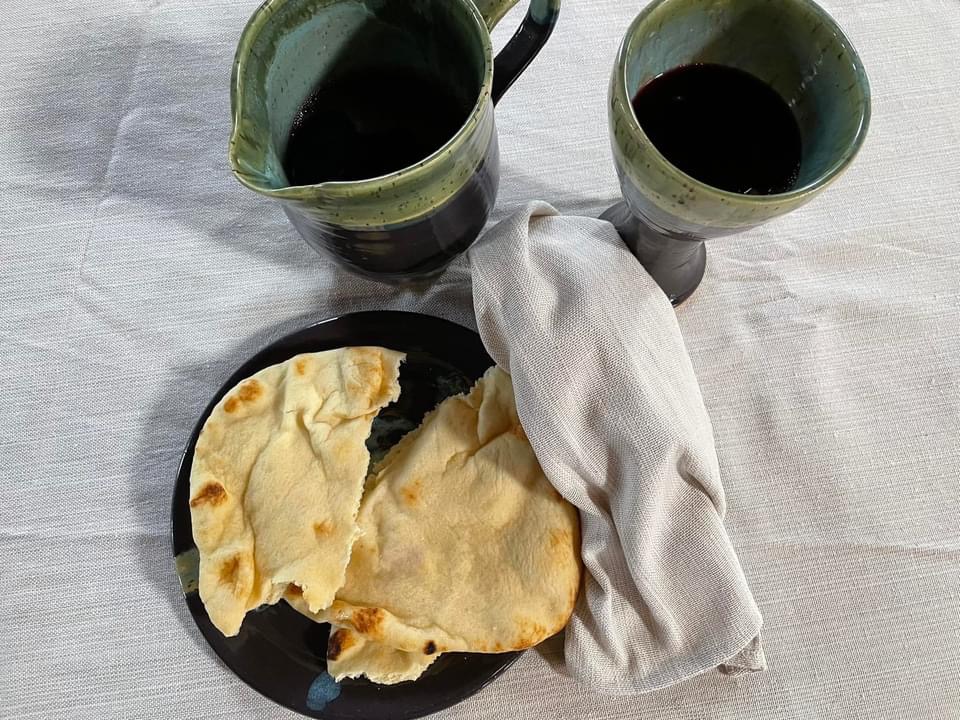
Bread and wine (grape juice): Jesus’ last supper with his disciples
And he said to them, “I have eagerly desired to eat this Passover with you before I suffer. For I tell you, I will not eat it again until it finds fulfillment in the kingdom of God.”
After taking the cup, he gave thanks and said, “Take this and divide it among you. For I tell you I will not drink again from the fruit of the vine until the kingdom of God comes.”
And he took bread, gave thanks and broke it, and gave it to them, saying, “This is my body given for you; do this in remembrance of me.”
In the same way, after the supper he took the cup, saying, “This cup is the new covenant in my blood, which is poured out for you.
Luke 22:15-20
What do you think when you taste grape juice outside of church?
What comes to mind when you smell fresh bread?
Why do you think Jesus chose these two regular things to be these special symbols for us?
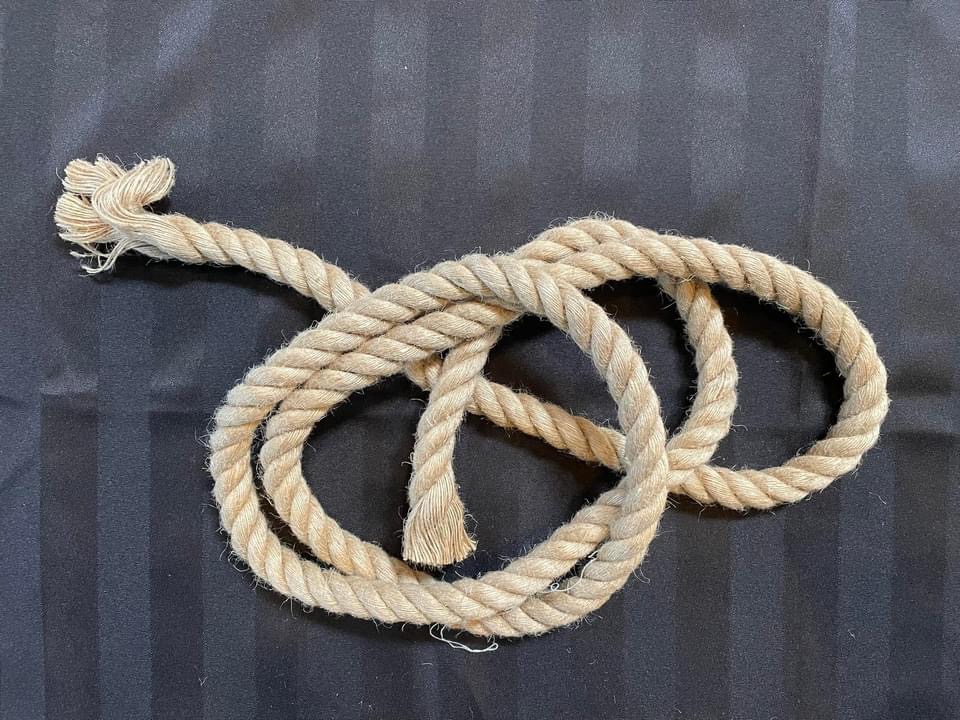
Rope: Jesus is arrested
While he was still speaking, Judas, one of the Twelve, arrived. With him was a large crowd armed with swords and clubs, sent from the chief priests and the elders of the people. Now the betrayer had arranged a signal with them: “The one I kiss is the man; arrest him.” Going at once to Jesus, Judas said, “Greetings, Rabbi!” and kissed him.
Jesus replied, “Do what you came for, friend.”
Then the men stepped forward, seized Jesus and arrested him. With that, one of Jesus’ companions reached for his sword, drew it out and struck the servant of the high priest, cutting off his ear.
“Put your sword back in its place,” Jesus said to him, “for all who draw the sword will die by the sword. Do you think I cannot call on my Father, and he will at once put at my disposal more than twelve legions of angels? But how then would the Scriptures be fulfilled that say it must happen in this way?”
In that hour Jesus said to the crowd, “Am I leading a rebellion, that you have come out with swords and clubs to capture me? Every day I sat in the temple courts teaching, and you did not arrest me. But this has all taken place that the writings of the prophets might be fulfilled.” Then all the disciples deserted him and fled.
Those who had arrested Jesus took him to Caiaphas the high priest, where the teachers of the law and the elders had assembled.
Matthew 26:47-57
How do you think Jesus felt in that moment?
Feel the rope. Is it comfortable and soft? How would you describe it?
How do you think it would have felt to be tied up tightly by the angry soldiers?
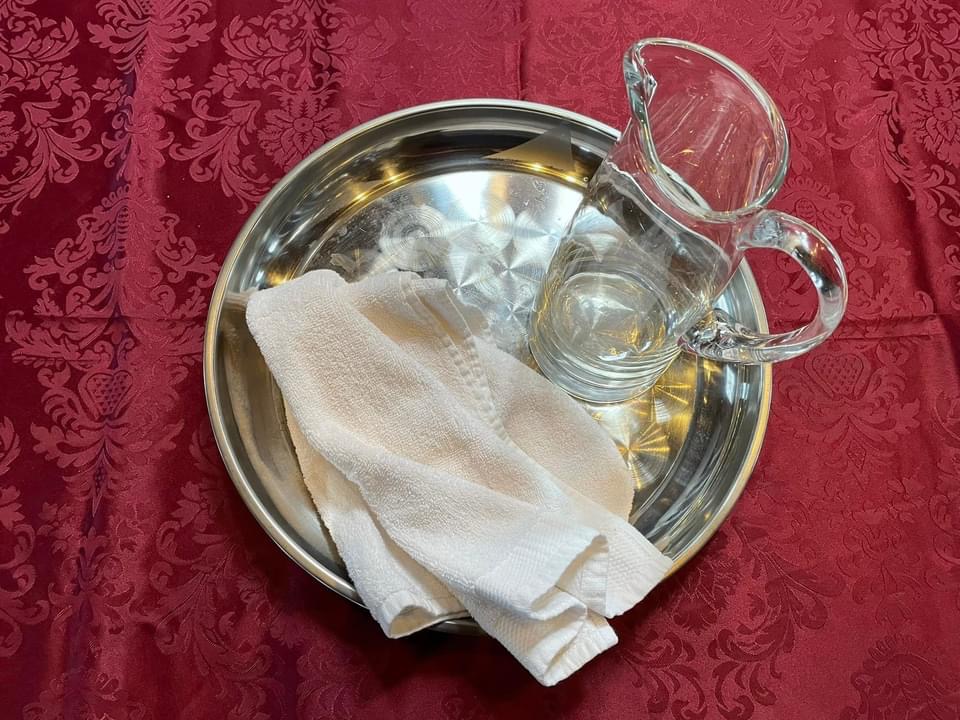
Water and towel: Jesus before Pilate
Meanwhile Jesus stood before the governor, and the governor asked him, “Are you the king of the Jews?”
“You have said so,” Jesus replied.
When he was accused by the chief priests and the elders, he gave no answer. Then Pilate asked him, “Don’t you hear the testimony they are bringing against you?” But Jesus made no reply, not even to a single charge—to the great amazement of the governor.
Now it was the governor’s custom at the festival to release a prisoner chosen by the crowd. At that time they had a well-known prisoner whose name was Jesus Barabbas. So when the crowd had gathered, Pilate asked them, “Which one do you want me to release to you: Jesus Barabbas, or Jesus who is called the Messiah?” For he knew it was out of self-interest that they had handed Jesus over to him.
While Pilate was sitting on the judge’s seat, his wife sent him this message: “Don’t have anything to do with that innocent man, for I have suffered a great deal today in a dream because of him.”
But the chief priests and the elders persuaded the crowd to ask for Barabbas and to have Jesus executed.
“Which of the two do you want me to release to you?” asked the governor.
“Barabbas,” they answered.
“What shall I do, then, with Jesus who is called the Messiah?” Pilate asked.
They all answered, “Crucify him!”
“Why? What crime has he committed?” asked Pilate.
But they shouted all the louder, “Crucify him!”
When Pilate saw that he was getting nowhere, but that instead an uproar was starting, he took water and washed his hands in front of the crowd. “I am innocent of this man’s blood,” he said. “It is your responsibility!”
All the people answered, “His blood is on us and on our children!”
Then he released Barabbas to them. But he had Jesus flogged, and handed him over to be crucified.
Matthew 27:11-26
Have you ever “washed your hands of something” and said it doesn’t matter to you…when inside you still cared so much? How did that feel?
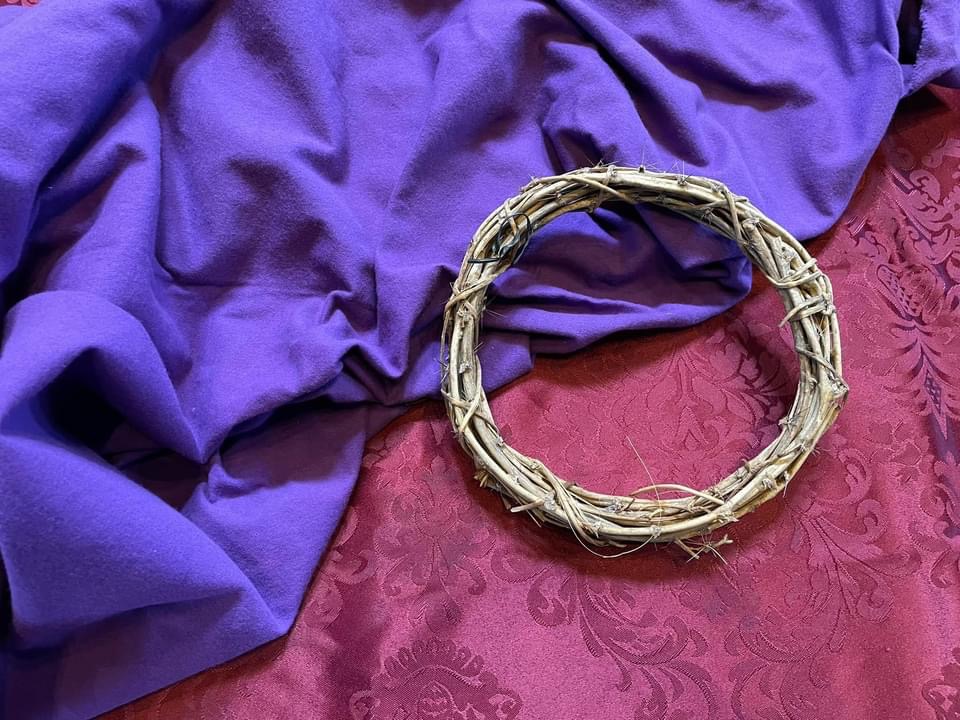
Crown of thorns: the soldiers mock Jesus
Then the governor’s soldiers took Jesus into the Praetorium and gathered the whole company of soldiers around him. They stripped him and put a scarlet robe on him, and then twisted together a crown of thorns and set it on his head. They put a staff in his right hand. Then they knelt in front of him and mocked him. “Hail, king of the Jews!” they said. They spit on him, and took the staff and struck him on the head again and again. After they had mocked him, they took off the robe and put his own clothes on him. Then they led him away to crucify him.
Matthew 27:27-31
How do you feel when people make fun of you?
If you were in Jesus’ place, what would you have done?

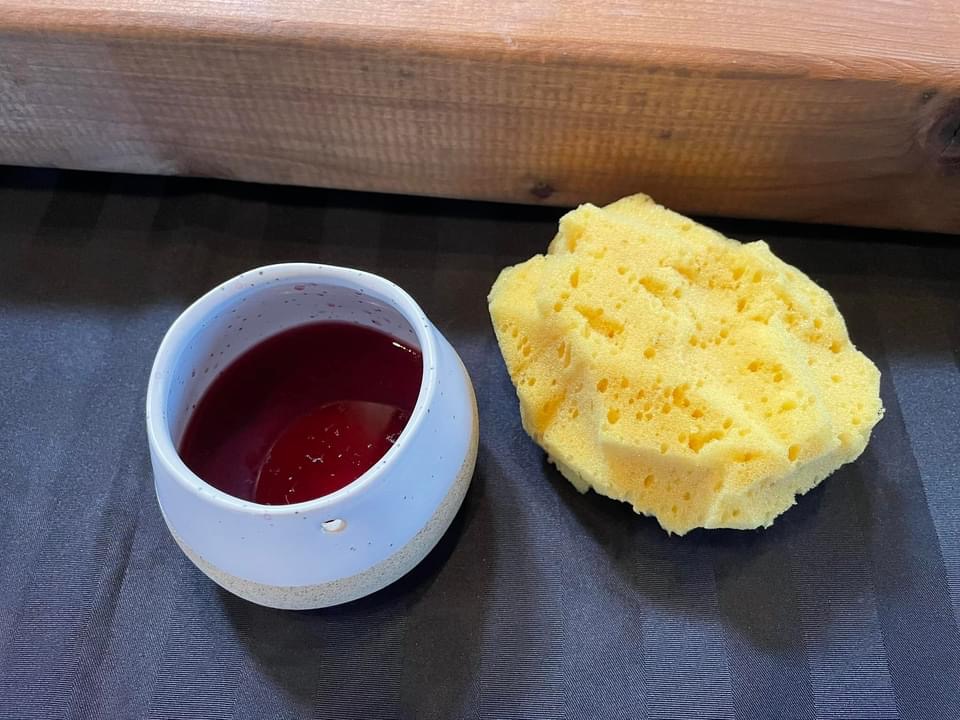
Nails + Vinegar: Jesus is crucified
So the soldiers took charge of Jesus. Carrying his own cross, he went out to the place of the Skull (which in Aramaic is called Golgotha). There they crucified him, and with him two others—one on each side and Jesus in the middle.
Pilate had a notice prepared and fastened to the cross. It read: jesus of nazareth, the king of the jews. Many of the Jews read this sign, for the place where Jesus was crucified was near the city, and the sign was written in Aramaic, Latin and Greek. The chief priests of the Jews protested to Pilate, “Do not write ‘The King of the Jews,’ but that this man claimed to be king of the Jews.”
Pilate answered, “What I have written, I have written.”
When the soldiers crucified Jesus, they took his clothes, dividing them into four shares, one for each of them, with the undergarment remaining. This garment was seamless, woven in one piece from top to bottom.
“Let’s not tear it,” they said to one another. “Let’s decide by lot who will get it.”
This happened that the scripture might be fulfilled that said,
“They divided my clothes among them
and cast lots for my garment.”
So this is what the soldiers did.
Near the cross of Jesus stood his mother, his mother’s sister, Mary the wife of Clopas, and Mary Magdalene. When Jesus saw his mother there, and the disciple whom he loved standing nearby, he said to her, “Woman, here is your son,” and to the disciple, “Here is your mother.” From that time on, this disciple took her into his home.
Later, knowing that everything had now been finished, and so that Scripture would be fulfilled, Jesus said, “I am thirsty.” A jar of wine vinegar was there, so they soaked a sponge in it, put the sponge on a stalk of the hyssop plant, and lifted it to Jesus’ lips. When he had received the drink, Jesus said, “It is finished.” With that, he bowed his head and gave up his spirit.
John 19:16b-30
Everything about how the Romans killed Jesus was about making him suffer. From hitting him, making him carry his heavy wooden cross for half a mile (almost one kilometer) and using nails instead of rope to hold him on the cross, to giving him venegar instead of water when he was thirsty.
Crucifixion was a slow and incredibly painful way to die. Jesus hung on the cross for probably close to 6 hours before he died.
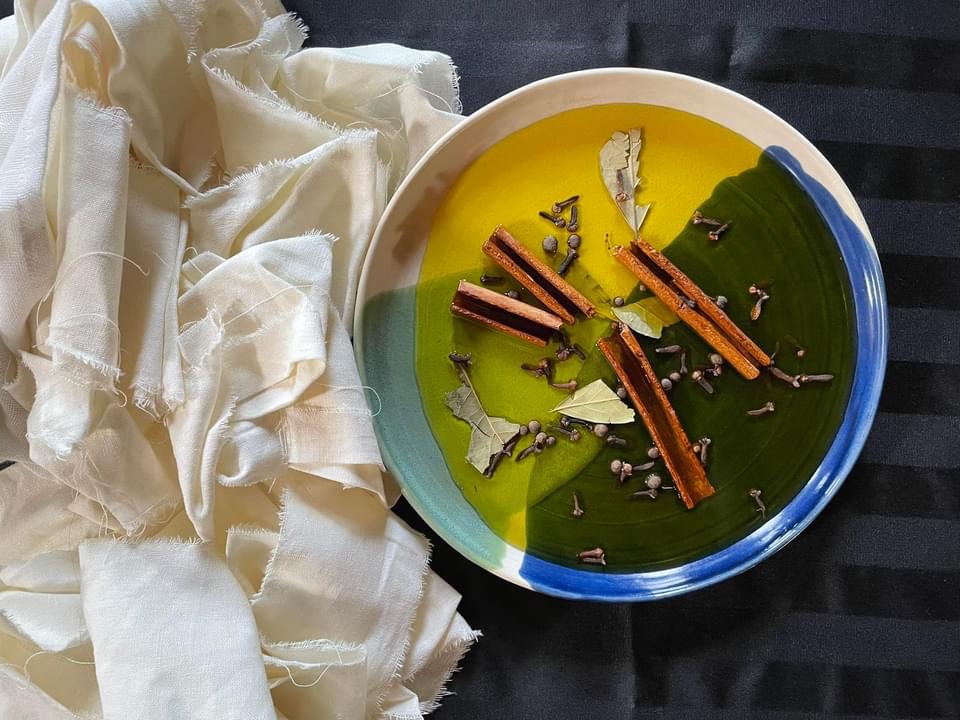
Spices and linen: Jesus is buried
Later, Joseph of Arimathea asked Pilate for the body of Jesus. Now Joseph was a disciple of Jesus, but secretly because he feared the Jewish leaders. With Pilate’s permission, he came and took the body away. He was accompanied by Nicodemus, the man who earlier had visited Jesus at night. Nicodemus brought a mixture of myrrh and aloes, about seventy-five pounds.Taking Jesus’ body, the two of them wrapped it, with the spices, in strips of linen. This was in accordance with Jewish burial customs. At the place where Jesus was crucified, there was a garden, and in the garden a new tomb, in which no one had ever been laid. Because it was the Jewish day of Preparation and since the tomb was nearby, they laid Jesus there.
John 19:38-42
The way a person is buried is the last chance that family and friends have to say how much they love that person.
In Jesus’ time, people did this by making sure the body was clean, had no bugs on it, and smelled nice by wrapping the body in strips of linen and covered the body with nice smelling oils, herbs, and spices.
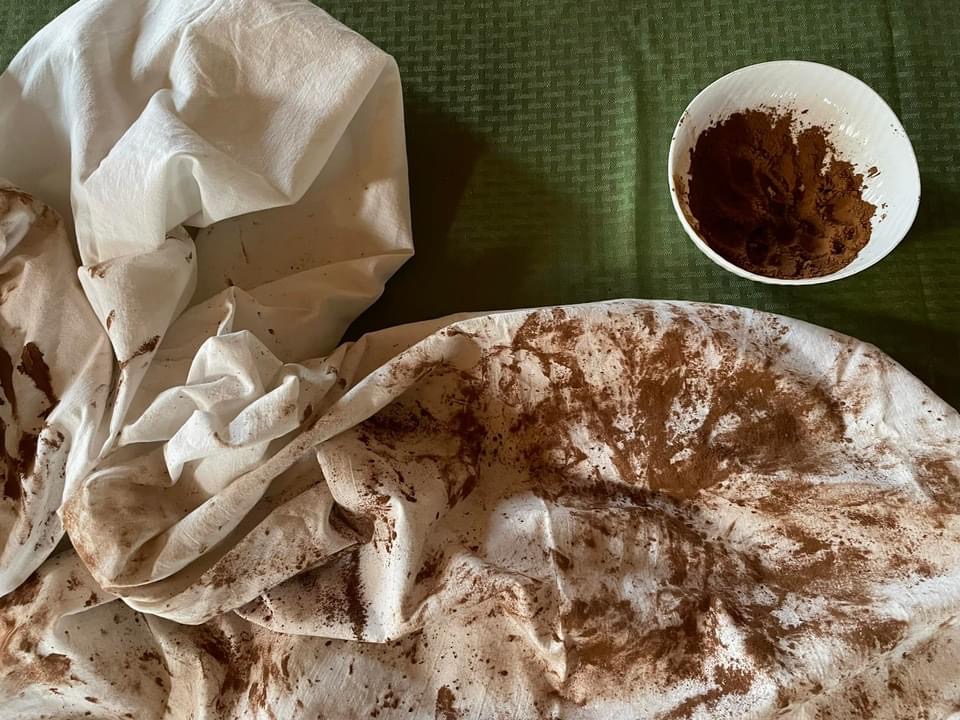
Cocoa powder: Jesus died for our sin
Even when Jesus died, he remained perfect. He never cursed or got angry at those who lied about him and treated him so poorly.
The white cloth represents the perfection of Jesus and the cocoa powder represents our sin.
You are encouraged to dip your fingers into the cocoa powder, say a prayer of thanks to God, and then wipe your hands clean on the cloth.
